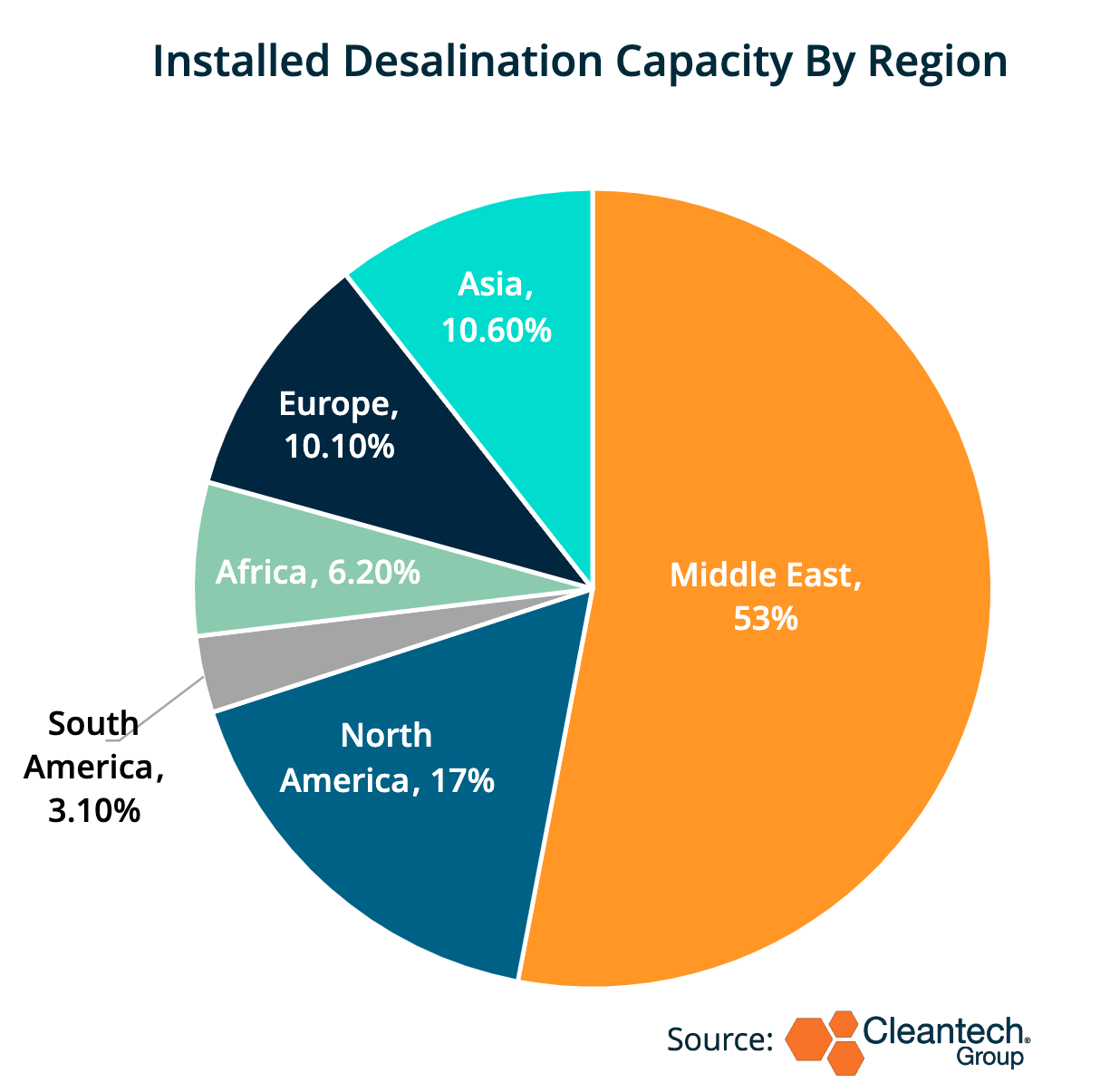Onshore vs. Offshore Desalination: Navigating the Future of Water Supply
In a world grappling with increasing water scarcity, desalination has emerged as a vital solution in the water management toolbox. As technological advancements continue, the focus has shifted towards optimizing desalination methods and integrating renewable energy sources. This blog delves into the comparative aspects of onshore and offshore desalination, highlighting the transformative potential of renewable energy in driving these processes.
The Growing Demand for Freshwater
Freshwater is a critical resource, yet excessive withdrawal of natural reserves, inefficient water management, climate change, and demographic growth have led to global water stress. Projections indicate that this will impact 4 billion people by 2030. Existing solutions for drought resilience face challenges such as high energy costs, high emissions from fossil fuels, and the risk of brine waste streams harming marine life. Desalination technology offers a viable alternative, yet choosing between onshore and offshore options requires careful consideration of their distinct benefits and challenges.
Onshore Desalination: Grounded and Proven
Onshore desalination plants, typically situated near coastlines, have been the cornerstone of desalination technology. They leverage established infrastructure and logistics networks, ensuring consistent operation and maintenance. The primary methods employed in onshore desalination include reverse osmosis (RO) and multi-stage flash distillation (MSF).
Advantages of Onshore Desalination:
1. Established Technologies: Onshore desalination technologies like reverse osmosis are well-established, readily deployable, and have undergone significant optimization, resulting in reliable performance, higher efficiency, and lower operational risks.
2. Infrastructure Integration: Onshore plants benefit from existing industrial infrastructure, making it easier to integrate with power and utility grids, thereby reducing initial capital expenditure and operational complexities.
3. Proximity to Demand Centers: These plants are often located close to urban areas where water demand is high, minimizing the costs and logistical challenges associated with transporting desalinated water.
4. Shorter Project Lead Times: Project lead times tend to be shorter due to less complex permitting and construction processes.
5. Hybrid Systems: Onshore facilities can implement hybrid desalination systems, combining reverse osmosis or forward osmosis with energy recovery from waste heat or integrating with co-generation plants to enhance overall efficiency.
Challenges of Onshore Desalination:
1. Brine Disposal: Onshore desalination plants typically produce brine that is twice as salty as the surrounding ambient environment into which they discharge, posing environmental risks.
2. Land Availability: Desalination plants require large industrial facilities located on coasts, taking up real estate needed for other uses, such as tourism, and restricting the access of local communities to the sea.
3. Energy Costs During Drought: While desalination plants located in estuaries and brackish groundwater sites, compared to seawater, can be overall more cost-effective, during drought, hydropower costs increase due to the scarcity of water, in turn raising energy costs and making traditional onshore desalination less viable when it is needed most.
Offshore Desalination: Innovation on the High Seas
Offshore desalination involves deploying desalination units on floating platforms or in subsea units, addressing some of the limitations associated with onshore plants. Offshore desalination offers unique advantages but also poses distinct challenges.
Advantages of Offshore Desalination:
1. Environmental Benefits: Offshore units can reduce the environmental impact associated with brine disposal by dispersing it over a larger area in deeper waters, minimizing the ecological footprint.
2. Land Use Efficiency: Offshore desalination eliminates the need for extensive coastal land, which is often scarce and expensive, making it an attractive option for densely populated coastal regions.
3. Mobility and Flexibility: Floating desalination units can be relocated based on shifting water demand patterns or in response to natural disasters, enhancing resilience and adaptability in water supply management.
4. Technological Synergy: Advancements in subsea exploration for oil and natural gas have made seafloor desalination possible, with companies like Waterise and Flocean reducing energy consumption by 40% through natural hydrostatic pressure.
5. Reduced Coastal Impact: Offshore plants can avoid issues like algal blooms, jellyfish, or other contaminants that demand pre-treatment costs if placed far enough from the coastline.
6. Collocation Opportunities: There is potential for desalination plants on artificial islands in the MENA region and colocation with other offshore facilities, such as power plants or offshore wind farms.
Challenges of Offshore Desalination:
1. Transport Costs: Transporting water from offshore plants to onshore distribution systems can vary due to logistical complexity and may require additional infrastructure.
2. Scalability: There is uncertainty concerning the scalability of systems to supply potable water to major inland offtakers.
Why Renewable Energy-Driven Desalination is a Game Changer:
The integration of renewable energy sources into desalination processes represents a paradigm shift towards sustainability. Solar, wind, and wave energy are increasingly being harnessed to power desalination plants, mitigating environmental impact, and reducing dependency on fossil fuels.
Utilizing renewable energy significantly lowers greenhouse gas emissions associated with desalination, drastically reducing the 400 million tons of CO2 emitted by plants powered by fossil fuels. Falling solar power costs and advancements in wave energy, coupled with efficiency improvements via membranes, have made renewable-powered desalination economically viable and cost-competitive.
Renewable energy sources also diversify the energy mix, enhancing energy security, crucial for regions with limited access to conventional energy resources. Innovative combinations of desalination technologies and renewable energy systems, such as solar-thermal desalination and wind-powered RO, optimize efficiency and operational performance.
Integrating renewable energy into desalination poses challenges such as the intermittent nature of renewable sources and the need for robust energy storage solutions. Initial capital investment can be high, necessitating strategic financial planning and potential government incentives. Furthermore, access to capital for innovators in low-to-middle-income nations has slowed deployment, relying on development finance banks with 2–3-year lead times.

Strategic Implications for Businesses
The market for desalination technologies is well-established, valued at $17B, and expected to grow with a CAGR of 9.43% by 2024-2029, reaching $32B in revenue by 2030. The global water deficit will increase fivefold by 2050, meaning that industrial offtakers and states in crisis will be primary consumers of desalinated water.
For businesses, the shift towards renewable energy-driven desalination presents lucrative opportunities. Companies can invest in or partner with innovative desalination projects, positioning themselves as leaders in sustainable water solutions. This enhances corporate social responsibility profiles and opens avenues for growth in emerging markets with critical water needs.
Emerging industries such as hydrogen production, mining, solar manufacturing, and sustainable aviation fuels will create a demand for freshwater that will likely outstrip global supply, generating new revenue streams for innovators. Membrane innovators have diversified revenue streams by pivoting to metal recovery, which could decrease costs in the long term for desalination as membrane production increases to meet demand.
As the global demand for freshwater escalates, the evolution of desalination technologies—both onshore and offshore—augmented by renewable energy, offers a strong case that will work in tandem with circular water strategies. Advanced climate risk analytics highlight that $425B of assets are at risk due to water scarcity, incentivizing action. The Carbon Disclosure Project estimates that inaction to water risks is up to five times the cost of action. By embracing these innovations, businesses can contribute to sustainable water management and harness new growth opportunities in an increasingly water-stressed world. Desalination is not just about making seawater drinkable; it’s about securing our planet’s most precious resource when we need it more than ever.



